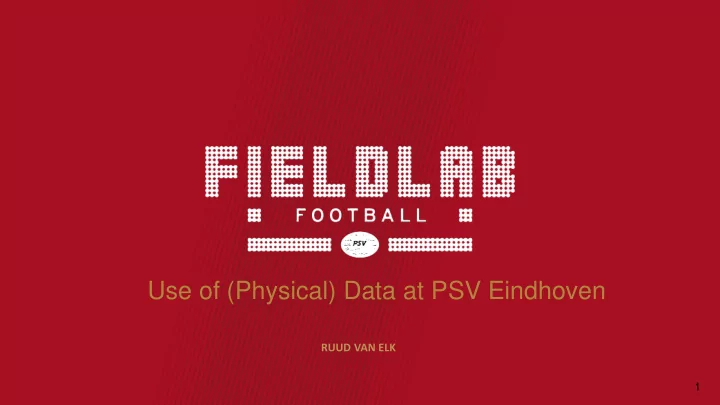

Use of (Physical) Data at PSV Eindhoven RUUD VAN ELK 1
2004
Fieldlab 2004 – First Collaboration with TNO 2005 – Installation 1 st Inmotio sytem 2012 – Start “ Fieldlab ” Project 2014 – New Inmotio LPM systems 2015 – Fully operational Fieldlab
Organization • Involvement from all over the club • Innovation committee • Departments involved: – Board – S&C – Sport Science – Medical & Mental – Video Analysis
Goals of data usage • Getting SIMPLE, CLEAR and FUNCTIONAL data to the coaches! 11-4-2016 5
General Data - Adress details - Partental data - Absence/attendance ‘ Wellness ’ Data Physical Data - Distance - Sleep - Muscle “feeling” - Number of Sprints - Heartrate - RPE Scores - Physical Testing PSV Database Tactische Data Overige Data? - Passing - School data? - Goals - Weather data? - Bookings - Ticketsales? - Distances within team - Fanstore? Mentale Data? Medische Data - Mindset? - Antropometry - Reactiontime (specific)? - Injuries - Learning capacity? Simple visual tool for coaches
Data on the trainingground
Data in the stadium (SportVU, STATS)
Real-Time Data
What do we measure? (1) • Positioning data alone tells NOTHING about football performance! – Combination with tactical view of the coach – Combination with video – Combination with tactical datasets (ORTEC) 10
What do we measure? (2) • Physical input instead of output! In general: Position data (1000 Hz!) - Speed / Distance / HID - Acceleration / Decelaration Heart rate Football specific Amount of football actions (per min) Covered distance of the football actions (per min) Accelerations (Heart rate) 11
Data (Filtered) 12
Databases and Coaches?
Database (1) – Player info 11-4-2016 14
Database (2) – Measurement info 11-4-2016 15
Database (3) – Physical Load Data 11-4-2016 16
Data Workflow Collection Analysis Reporting Reporting Coaches 17
During the training- Physical • Individual details on: – Decrease in labor (fatigue) – e.g. #football actions/min in combination with heart rate (recovery) – Direct feedback on supplied labor – Monitoring individual labor (e.g. in rehabilitation) 18
After the training - physical • Individual – Monitoring individual development – Football conditioning, speed, power. – Objective information about reached intensity – Direct feedback to players about (physical) performance – Motivating / confronting • Team – Comparing different exercises – For instance, the difference in load between 11v11 – 5v5 or between passing exercises vs. position games – Objective information about build up of the training week – Development from a football conditioning point of view • Youth Academy – Comparing the training load between the first team and the youth teams. 19
Report per player / Team 20
Physical Testing 21
Physical Testing – Dressing Room Report 22
Physical Testing – Individual Report 23
How do we use these reports in daily practice? • Monitoring of individual development • Support in choice of individual programs • Feedback to staff about program • Support medical department • Building of normal values per position / age group • Scouting 11-4-2016 24
Future: Blending in different streams of data Tactical Data Scoring, Passing, effectivity Medical Data Injury, Antropometric data Welness Data Sleep, RPE scores Conignitive Data Reaction Timing, Learning Skills Maybe even more? 25
Challenges we face 1. Developing a smart IT infrastructure to gain, save and backup data and couple different input sources in real time 2. Matching tactical data on physical data 3. Developing smart models and algorithms to analyze the data 26
Data and Statistics – considerations and limitations • Interpretation of variables • Data of different systems not comparable • Not all actions can be measured in a practical situation (e.g. shooting, tackling) • Specialist help necessary • Budget considerations • Rules (FIFA/UEFA/KNVB) 27
28
Contact: Ruud van Elk MSc. +31631099912 r.vanelk@psv.nl
Recommend
More recommend